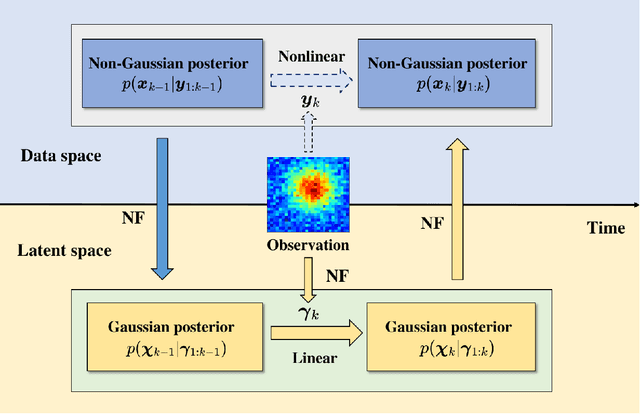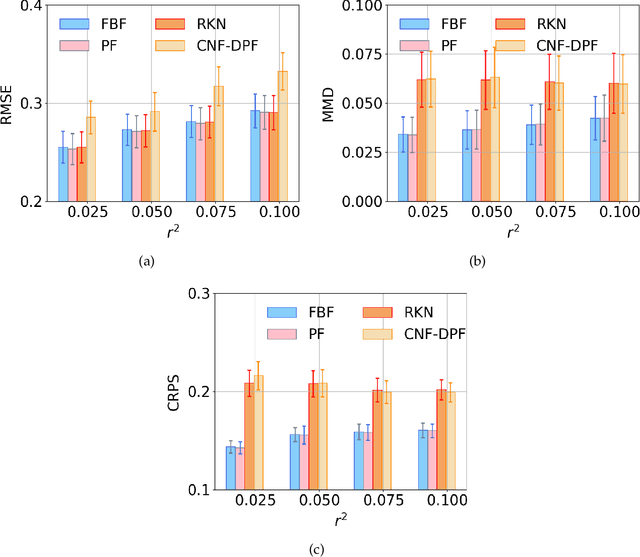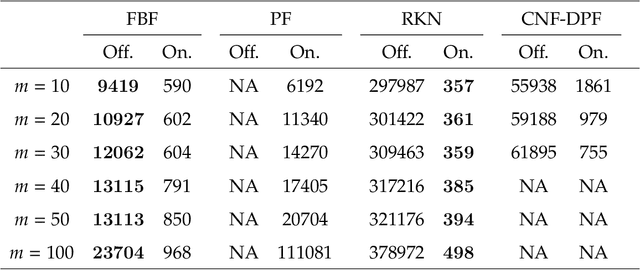Xiaofei Guan
Flow-based linear embedding for Bayesian filtering of nonlinear stochastic dynamical systems
Feb 22, 2025



Abstract:Bayesian filtering for high-dimensional nonlinear stochastic dynamical systems is a fundamental yet challenging problem in many fields of science and engineering. Existing methods face significant obstacles: Gaussian-based filters struggle with non-Gaussian distributions, sequential Monte Carlo methods are computationally intensive and prone to particle degeneracy in high dimensions, and deep learning approaches often fail to balance accuracy and efficiency in complex filtering tasks. To address these challenges, we propose a flow-based Bayesian filter (FBF) that integrates normalizing flows to construct a latent linear state-space model with Gaussian filtering distributions. This framework enables efficient density estimation and sampling through invertible transformations provided by normalizing flows, which can be learned directly from data, thereby eliminating the need for prior knowledge of system dynamics or observation models. Numerical experiments demonstrate the advantages of FBF in terms of both accuracy and efficiency.
Efficient Bayesian inference using physics-informed invertible neural networks for inverse problems
Apr 26, 2023Abstract:In the paper, we propose a novel approach for solving Bayesian inverse problems with physics-informed invertible neural networks (PI-INN). The architecture of PI-INN consists of two sub-networks: an invertible neural network (INN) and a neural basis network (NB-Net). The invertible map between the parametric input and the INN output with the aid of NB-Net is constructed to provide a tractable estimation of the posterior distribution, which enables efficient sampling and accurate density evaluation. Furthermore, the loss function of PI-INN includes two components: a residual-based physics-informed loss term and a new independence loss term. The presented independence loss term can Gaussianize the random latent variables and ensure statistical independence between two parts of INN output by effectively utilizing the estimated density function. Several numerical experiments are presented to demonstrate the efficiency and accuracy of the proposed PI-INN, including inverse kinematics, inverse problems of the 1-d and 2-d diffusion equations, and seismic traveltime tomography.
Deep learning based automatic segmentation of lumbosacral nerves on non-contrast CT for radiographic evaluation: a pilot study
Nov 28, 2018



Abstract:Background and objective: Combined evaluation of lumbosacral structures (e.g. nerves, bone) on multimodal radiographic images is routinely conducted prior to spinal surgery and interventional procedures. Generally, magnetic resonance imaging is conducted to differentiate nerves, while computed tomography (CT) is used to observe bony structures. The aim of this study is to investigate the feasibility of automatically segmenting lumbosacral structures (e.g. nerves & bone) on non-contrast CT with deep learning. Methods: a total of 50 cases with spinal CT were manually labeled for lumbosacral nerves and bone with Slicer 4.8. The ratio of training: validation: testing is 32:8:10. A 3D-Unet is adopted to build the model SPINECT for automatically segmenting lumbosacral structures. Pixel accuracy, IoU, and Dice score are used to assess the segmentation performance of lumbosacral structures. Results: the testing results reveals successful segmentation of lumbosacral bone and nerve on CT. The average pixel accuracy is 0.940 for bone and 0.918 for nerve. The average IoU is 0.897 for bone and 0.827 for nerve. The dice score is 0.945 for bone and 0.905 for nerve. Conclusions: this pilot study indicated that automatic segmenting lumbosacral structures (nerves and bone) on non-contrast CT is feasible and may have utility for planning and navigating spinal interventions and surgery.
 Add to Chrome
Add to Chrome Add to Firefox
Add to Firefox Add to Edge
Add to Edge